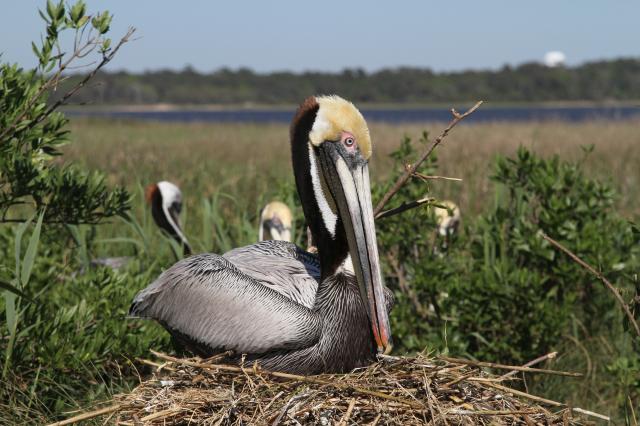Each month we feature one of the 97 IBAs (Important Bird Area) in North Carolina. This month we are showcasing the unique habitats of the Beacon Island IBA. This post is written by Audubon North Carolina’s Lindsay Addison.
You can help support these diverse and amazing bird areas. Your donation to "Give the Birds One More Day, Help Protect an IBA" will go directly to conducting compelling research, forming collaborations with land trusts and other nonprofit organizations, and actively protecting Important Bird Areas throughout North Carolina. Consider making a gift today!
Beacon Island is a small marshy island near Ocracoke Inlet. Surrounding it are seagrass flats, shallow waters, and oyster bars. Its 8 acres are a rich habitat for nesting birds such as Brown Pelican, American Oystercatcher, Laughing Gull, and Forster’s Tern. Brant winter in the shallow waters surrounding it. Audubon staff post this sanctuary island to monitor nesting and migrating birds.
Pelican Sanctuary

Nesting Brown Pelican. Photo by Audubon North Carolina.
The island’s claim to fame lies with its pelicans. It was on Beacon Island that Brown Pelicans were first recorded breeding in North Carolina in 1928. The population ran into trouble with the widespread use of DDT and other pesticides, and the species was placed on the Endangered Species List in 1970. Some chemicals caused direct mortality, while DDT caused many bird species’ numbers to plummet by accumulating in their fatty tissue and causing their eggshells to be too thin to support the weight of the incubating parents. Following the ban of DDT in 1972, pelicans began to do better, and Beacon Island was the site of their first comeback in North Carolina. Now, as many as 900 pairs of Brown Pelicans may nest on Beacon Island.
The pelicans on Beacon Island have been so successful because it meets their simple requirements for nesting habitat:
- High Ground: In most years, the island is just high enough to avoid being washed over, although hurricanes or other storms sometimes sweep eggs and chicks away.
- Safety for Chicks: The Island is free of disturbance such as mammalian predators, humans, and pet dogs. Mammals like raccoons may prey on eggs and chicks, and disturbance from any source can cause nesting adults to abandon a colony site or leave eggs and chicks exposed to extreme conditions.
- Ample Nesting Materials: The Island’s marshy vegetation provides pelicans with on-site nest material, making the island more attractive, but unlike some other species, pelicans do not require bare sand for nesting. Instead, the male brings twigs, branches, and other material to the female who constructs the nest.
A Meal on Beacon Island
If a bird, like the Brown Pelican, is equipped with a pouch it is natural to think that they use that pouch to carry fish back to their chicks. However, pelicans swallow the fish—usually bait fish like menhaden—they catch and regurgitate them for chicks back at the nest.
A half-grown chick (well over a month old) rummages around its parent’s throat for fish. Photo by Hank Heusinkveld.
Adults start by regurgitating mostly digested fish, and the tiny featherless chicks peck them off the ground. When the chicks are bigger, the chicks begin to intercept regurgitated fish by sticking their heads down their parents’ throats or in their pouches, where some of the fish may accumulate.
In August, pelican chicks on Beacon Island will vary greatly. Some are still partially covered in white down, like the chick pictured above, while others are ready to fledge 12-weeks old birds learning to catch their own fish.



